Leadership Comparison: Transformational, Servant, and Authentic Styles
VerifiedAdded on 2022/11/30
|10
|2302
|325
Report
AI Summary
This paper provides a comprehensive comparison of three distinct leadership styles: transformational, servant, and authentic leadership. It begins by defining each style, exploring their core principles, and examining their respective strengths and weaknesses. The analysis delves into the practical applications of each leadership approach, offering real-world examples to illustrate their effectiveness in various scenarios. The paper highlights the parallels and differences between these styles, discussing how they influence motivation, morale, and overall performance within an organization. The author concludes by advocating for the use of transformational leadership, while also acknowledging the value of incorporating elements from authentic and servant leadership models based on situational requirements and the needs of the followers involved. The paper draws upon scholarly sources to support its arguments and provides a well-rounded understanding of the nuances of these leadership styles.
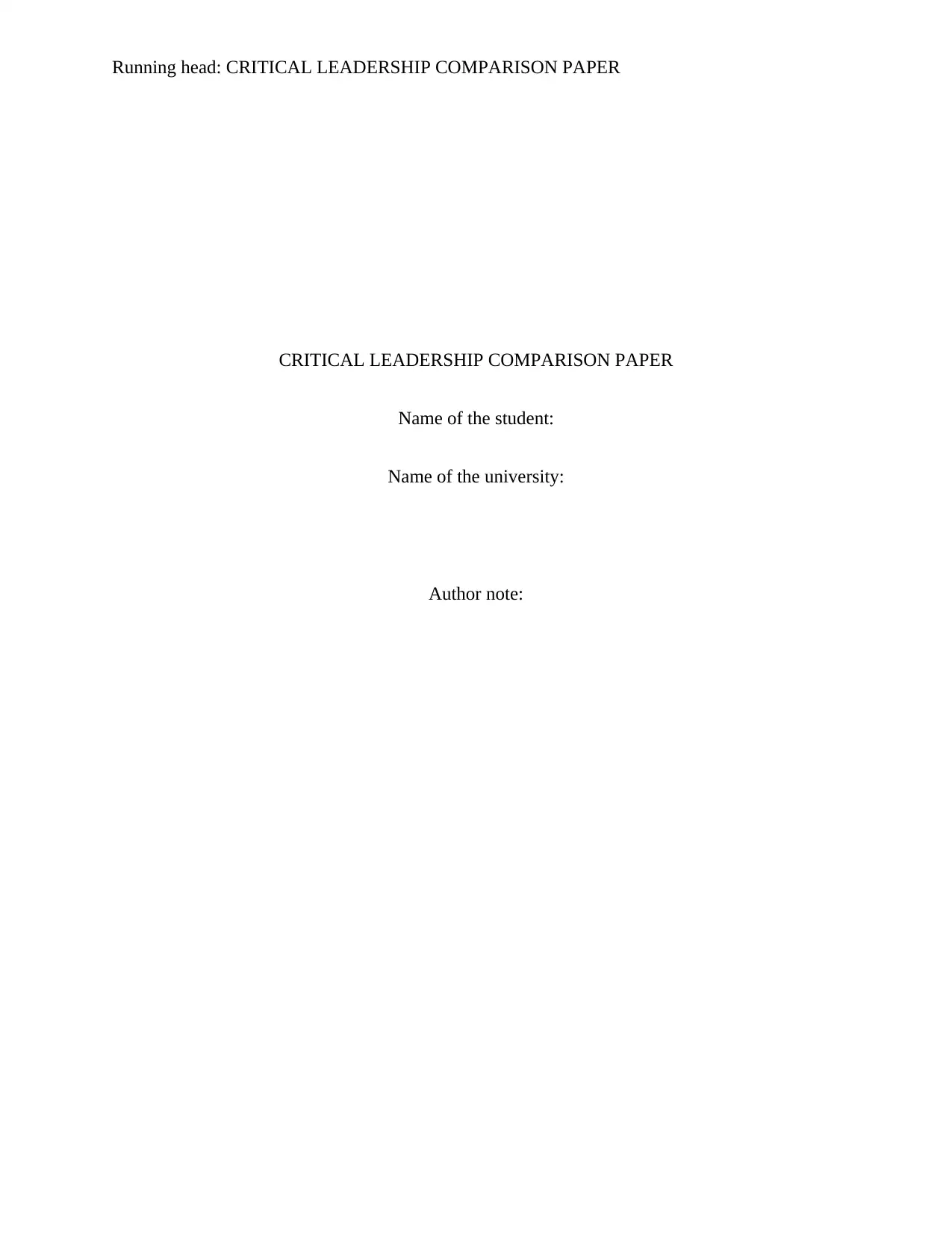
Running head: CRITICAL LEADERSHIP COMPARISON PAPER
CRITICAL LEADERSHIP COMPARISON PAPER
Name of the student:
Name of the university:
Author note:
CRITICAL LEADERSHIP COMPARISON PAPER
Name of the student:
Name of the university:
Author note:
Paraphrase This Document
Need a fresh take? Get an instant paraphrase of this document with our AI Paraphraser
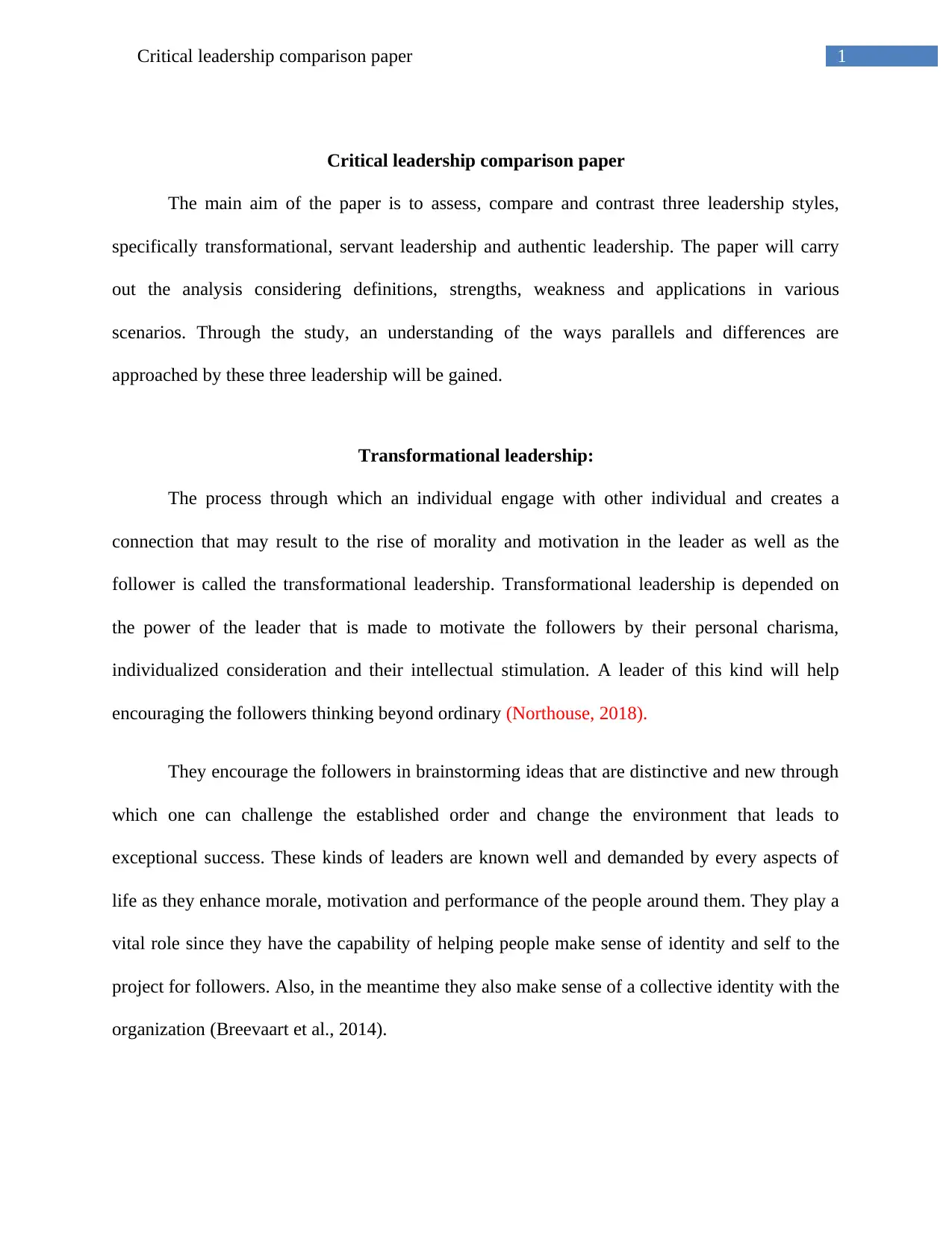
1Critical leadership comparison paper
Critical leadership comparison paper
The main aim of the paper is to assess, compare and contrast three leadership styles,
specifically transformational, servant leadership and authentic leadership. The paper will carry
out the analysis considering definitions, strengths, weakness and applications in various
scenarios. Through the study, an understanding of the ways parallels and differences are
approached by these three leadership will be gained.
Transformational leadership:
The process through which an individual engage with other individual and creates a
connection that may result to the rise of morality and motivation in the leader as well as the
follower is called the transformational leadership. Transformational leadership is depended on
the power of the leader that is made to motivate the followers by their personal charisma,
individualized consideration and their intellectual stimulation. A leader of this kind will help
encouraging the followers thinking beyond ordinary (Northouse, 2018).
They encourage the followers in brainstorming ideas that are distinctive and new through
which one can challenge the established order and change the environment that leads to
exceptional success. These kinds of leaders are known well and demanded by every aspects of
life as they enhance morale, motivation and performance of the people around them. They play a
vital role since they have the capability of helping people make sense of identity and self to the
project for followers. Also, in the meantime they also make sense of a collective identity with the
organization (Breevaart et al., 2014).
Critical leadership comparison paper
The main aim of the paper is to assess, compare and contrast three leadership styles,
specifically transformational, servant leadership and authentic leadership. The paper will carry
out the analysis considering definitions, strengths, weakness and applications in various
scenarios. Through the study, an understanding of the ways parallels and differences are
approached by these three leadership will be gained.
Transformational leadership:
The process through which an individual engage with other individual and creates a
connection that may result to the rise of morality and motivation in the leader as well as the
follower is called the transformational leadership. Transformational leadership is depended on
the power of the leader that is made to motivate the followers by their personal charisma,
individualized consideration and their intellectual stimulation. A leader of this kind will help
encouraging the followers thinking beyond ordinary (Northouse, 2018).
They encourage the followers in brainstorming ideas that are distinctive and new through
which one can challenge the established order and change the environment that leads to
exceptional success. These kinds of leaders are known well and demanded by every aspects of
life as they enhance morale, motivation and performance of the people around them. They play a
vital role since they have the capability of helping people make sense of identity and self to the
project for followers. Also, in the meantime they also make sense of a collective identity with the
organization (Breevaart et al., 2014).
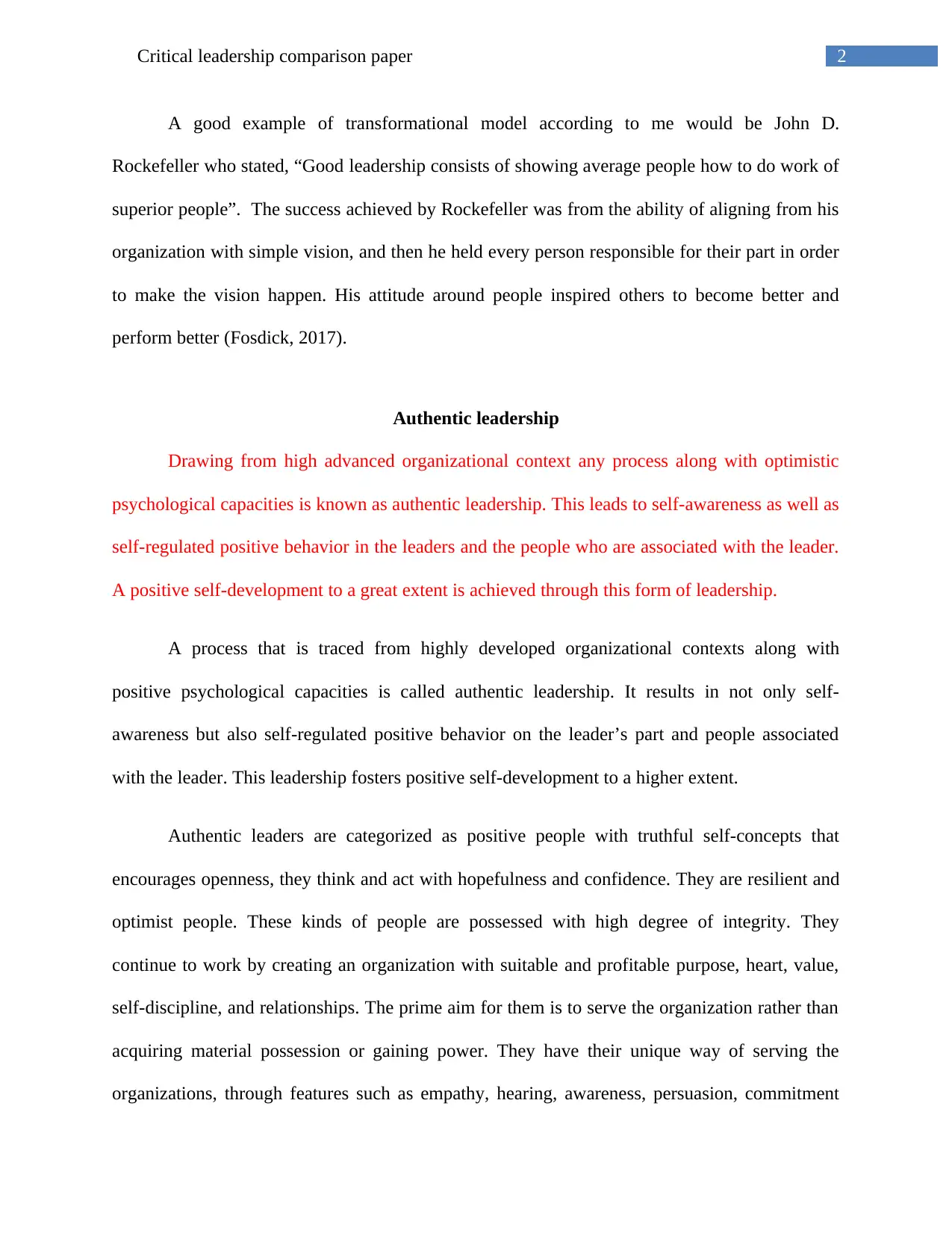
2Critical leadership comparison paper
A good example of transformational model according to me would be John D.
Rockefeller who stated, “Good leadership consists of showing average people how to do work of
superior people”. The success achieved by Rockefeller was from the ability of aligning from his
organization with simple vision, and then he held every person responsible for their part in order
to make the vision happen. His attitude around people inspired others to become better and
perform better (Fosdick, 2017).
Authentic leadership
Drawing from high advanced organizational context any process along with optimistic
psychological capacities is known as authentic leadership. This leads to self-awareness as well as
self-regulated positive behavior in the leaders and the people who are associated with the leader.
A positive self-development to a great extent is achieved through this form of leadership.
A process that is traced from highly developed organizational contexts along with
positive psychological capacities is called authentic leadership. It results in not only self-
awareness but also self-regulated positive behavior on the leader’s part and people associated
with the leader. This leadership fosters positive self-development to a higher extent.
Authentic leaders are categorized as positive people with truthful self-concepts that
encourages openness, they think and act with hopefulness and confidence. They are resilient and
optimist people. These kinds of people are possessed with high degree of integrity. They
continue to work by creating an organization with suitable and profitable purpose, heart, value,
self-discipline, and relationships. The prime aim for them is to serve the organization rather than
acquiring material possession or gaining power. They have their unique way of serving the
organizations, through features such as empathy, hearing, awareness, persuasion, commitment
A good example of transformational model according to me would be John D.
Rockefeller who stated, “Good leadership consists of showing average people how to do work of
superior people”. The success achieved by Rockefeller was from the ability of aligning from his
organization with simple vision, and then he held every person responsible for their part in order
to make the vision happen. His attitude around people inspired others to become better and
perform better (Fosdick, 2017).
Authentic leadership
Drawing from high advanced organizational context any process along with optimistic
psychological capacities is known as authentic leadership. This leads to self-awareness as well as
self-regulated positive behavior in the leaders and the people who are associated with the leader.
A positive self-development to a great extent is achieved through this form of leadership.
A process that is traced from highly developed organizational contexts along with
positive psychological capacities is called authentic leadership. It results in not only self-
awareness but also self-regulated positive behavior on the leader’s part and people associated
with the leader. This leadership fosters positive self-development to a higher extent.
Authentic leaders are categorized as positive people with truthful self-concepts that
encourages openness, they think and act with hopefulness and confidence. They are resilient and
optimist people. These kinds of people are possessed with high degree of integrity. They
continue to work by creating an organization with suitable and profitable purpose, heart, value,
self-discipline, and relationships. The prime aim for them is to serve the organization rather than
acquiring material possession or gaining power. They have their unique way of serving the
organizations, through features such as empathy, hearing, awareness, persuasion, commitment
⊘ This is a preview!⊘
Do you want full access?
Subscribe today to unlock all pages.

Trusted by 1+ million students worldwide

3Critical leadership comparison paper
and stewardship to the development of human resources and a commitment to community
building (Leroy et al. 2015).
An authentic leader is true and genuine to their principles, believes and thoughts. They
are aware of their purpose of leadership, therefore they certainly lead with consistent value with
their head as well as their heart. Courage, empathy, compassion and building long-term
connection relationship are easily found as their traits. Considering the results from their team,
they are possessed with personal self-discipline along with their teams.
One of the excellent examples of authentic leadership according to my personal opinion
is U.S civil rights movement leader Martin Luther King Jr. he reveled authentic leadership
qualities such as being open to others, being true to oneself, being honest and doing the right
thing. He led many people including all races and gender in order to come together to fight
discrimination (McKibben, Umstead & Borders, 2017).
Servant leadership
Servant leadership can be defined as a philosophy and set of practices that helps in
enriching the lives of every individual and build a better organization which ultimately make a
more just and caring world.
These kinds of leadership involve servant individuals who are naturally born to help.
Servant individuals are always willing to volunteer at some power before they are positioned into
either managers or supervisors. They have the assumption of developing and enabling their
employees. They get the strength and prioritize the demands of their employees more than any
other. These leaders are participative individuals who are engaged deeply with their employees
in order to understand their problems (Liden et al., 2014). They tend to gain knowledge of the
and stewardship to the development of human resources and a commitment to community
building (Leroy et al. 2015).
An authentic leader is true and genuine to their principles, believes and thoughts. They
are aware of their purpose of leadership, therefore they certainly lead with consistent value with
their head as well as their heart. Courage, empathy, compassion and building long-term
connection relationship are easily found as their traits. Considering the results from their team,
they are possessed with personal self-discipline along with their teams.
One of the excellent examples of authentic leadership according to my personal opinion
is U.S civil rights movement leader Martin Luther King Jr. he reveled authentic leadership
qualities such as being open to others, being true to oneself, being honest and doing the right
thing. He led many people including all races and gender in order to come together to fight
discrimination (McKibben, Umstead & Borders, 2017).
Servant leadership
Servant leadership can be defined as a philosophy and set of practices that helps in
enriching the lives of every individual and build a better organization which ultimately make a
more just and caring world.
These kinds of leadership involve servant individuals who are naturally born to help.
Servant individuals are always willing to volunteer at some power before they are positioned into
either managers or supervisors. They have the assumption of developing and enabling their
employees. They get the strength and prioritize the demands of their employees more than any
other. These leaders are participative individuals who are engaged deeply with their employees
in order to understand their problems (Liden et al., 2014). They tend to gain knowledge of the
Paraphrase This Document
Need a fresh take? Get an instant paraphrase of this document with our AI Paraphraser

4Critical leadership comparison paper
requirements of the task or plans, and then make the employees choose their suitable course of
action. They do not impose their decisions but involve the other employees on mostly all
decisions that can increase cohesion and improve productivity.
Through the examination of the needs of individuals, a servant leader makes their move
towards problem solving. They ask the ways people can solve problems and promote personal
development. She or he emphases not only on the content but also on the people and encourages
individuals to enables them achieve their goals, met their expectations and reach their objectives.
As traits are discussed the appropriate example of the servant leader would be the US
president Abraham Lincoln. Lincoln possessed the two main traits of a servant leader. Firstly, the
idea of sustainable change that retains long time is found in him. Secondly the long term change
needed in servant leadership in him.
It is important to note, that Lincoln was also able to revolutionize the organizations of the
US government. He empowered the citizens in order to seek things that are greater. He was an
exceptional leader that worked towards the greater good of the people. Also, the position of
presidency was not sought by him for the sake of power rather to serve people of the country
(Brown, 2016).
Compare and contrast
As discussed above, there are certain differences between the styles of leadership
definition and core values. While in few places they overlap, there are few areas where they
differ in their behaviors. Some of the differences and similarities will be discussed below:
requirements of the task or plans, and then make the employees choose their suitable course of
action. They do not impose their decisions but involve the other employees on mostly all
decisions that can increase cohesion and improve productivity.
Through the examination of the needs of individuals, a servant leader makes their move
towards problem solving. They ask the ways people can solve problems and promote personal
development. She or he emphases not only on the content but also on the people and encourages
individuals to enables them achieve their goals, met their expectations and reach their objectives.
As traits are discussed the appropriate example of the servant leader would be the US
president Abraham Lincoln. Lincoln possessed the two main traits of a servant leader. Firstly, the
idea of sustainable change that retains long time is found in him. Secondly the long term change
needed in servant leadership in him.
It is important to note, that Lincoln was also able to revolutionize the organizations of the
US government. He empowered the citizens in order to seek things that are greater. He was an
exceptional leader that worked towards the greater good of the people. Also, the position of
presidency was not sought by him for the sake of power rather to serve people of the country
(Brown, 2016).
Compare and contrast
As discussed above, there are certain differences between the styles of leadership
definition and core values. While in few places they overlap, there are few areas where they
differ in their behaviors. Some of the differences and similarities will be discussed below:

5Critical leadership comparison paper
There are relatively analogues characteristics between transformational leadership and
servant leadership. This can be possible as both the type of leadership is attempted to explain and
define people-oriented leadership. As per both the concept, their leadership framework is
incorporated with vision, influence, trust, respect or credibility, integrity, risk sharing or
delegation and modeling. In actuality, the theories are prone to be similar for their emphasis
upon appreciation of followers and individualized consideration.
By and by, servant leadership and transformational leadership do have purposes of
variety. The servant leadership underscores the advancement of individual potential and self-
awareness for the followers that follows him or her, while a transformational leader focuses on
expanding development and inventiveness for their employees. This idea is significant as it
represents the focal point of the servant leader on self-improvement and the focal point of the
change chief on corporate advancement (Van Dierendonck et al., 2014). The servant leader put
more attention on the practices of acknowledging individuals and gaining from others on a
passionate dimension. The leader’s main focus is the primary qualification to note between
transformative leader and servant leader. Even though transformative leaders and servant leaders
are both worried about their followers the servant leader’s chief focus is to serve the followers
(McCleskey, 2014).
Considering the servant leadership and authentic leadership features, it may seem that
they share various characteristics however they also have several unique aspects when comes to
serving other needs. Servant leadership’s core principle is to give priority to the interest of
others. The chief duty of leaders is serving others and fulfilling their needs, desires and
aspirations. On the other hand authentic leadership does not involve the leaders to be too
representative to the other’s desires (Hoch et al., 2018).
There are relatively analogues characteristics between transformational leadership and
servant leadership. This can be possible as both the type of leadership is attempted to explain and
define people-oriented leadership. As per both the concept, their leadership framework is
incorporated with vision, influence, trust, respect or credibility, integrity, risk sharing or
delegation and modeling. In actuality, the theories are prone to be similar for their emphasis
upon appreciation of followers and individualized consideration.
By and by, servant leadership and transformational leadership do have purposes of
variety. The servant leadership underscores the advancement of individual potential and self-
awareness for the followers that follows him or her, while a transformational leader focuses on
expanding development and inventiveness for their employees. This idea is significant as it
represents the focal point of the servant leader on self-improvement and the focal point of the
change chief on corporate advancement (Van Dierendonck et al., 2014). The servant leader put
more attention on the practices of acknowledging individuals and gaining from others on a
passionate dimension. The leader’s main focus is the primary qualification to note between
transformative leader and servant leader. Even though transformative leaders and servant leaders
are both worried about their followers the servant leader’s chief focus is to serve the followers
(McCleskey, 2014).
Considering the servant leadership and authentic leadership features, it may seem that
they share various characteristics however they also have several unique aspects when comes to
serving other needs. Servant leadership’s core principle is to give priority to the interest of
others. The chief duty of leaders is serving others and fulfilling their needs, desires and
aspirations. On the other hand authentic leadership does not involve the leaders to be too
representative to the other’s desires (Hoch et al., 2018).
⊘ This is a preview!⊘
Do you want full access?
Subscribe today to unlock all pages.

Trusted by 1+ million students worldwide

6Critical leadership comparison paper
The three types of leaderships have an acute desire of supporting others and have a
genuine interest for empowering people. They are attached to their morals, values and
convictions. Considering all the three styles the relationship between leaders and followers are of
great significance. The leaders of these specific styles possess highly charismatic personality.
They are capable of influence and achieving the final objectives.
After the discussion, if I were to select a leadership style to use in my organization, my
choice would be transformational leadership. This would be anchor approach along with various
elements of philosophies of business leadership. The leadership approach is suitable as per my
thinking and I will consider using this approach. I would certainly consider utilizing the
authentic as well as servant leadership models changing as required. The interchanging would be
depended on situation and the followers indulged in the project. I would begin considering a
specific vision, and work towards it, followed by foster empowerment and consider each
person’s individual needs. Added to it, in order to enhance the job orientation, I would consider
convincing people about the feasibility of the mission and vision. Also, I would renew their
commitment and enthusiasm. After than it would inspire and enable followers to commit to the
shared vision.
Conclusion:
In the end, to summarize leadership styles can be defined as the way through which a
leader achieves his objectives. The contemporary world has become complicated society and
dynamic in its form. In the recent days, the requirement is not a single type of leadership
however it requires a leadership style that can be molded as per the situation and condition. A
leader must adapt different leadership styles to address problems in the organization as every
The three types of leaderships have an acute desire of supporting others and have a
genuine interest for empowering people. They are attached to their morals, values and
convictions. Considering all the three styles the relationship between leaders and followers are of
great significance. The leaders of these specific styles possess highly charismatic personality.
They are capable of influence and achieving the final objectives.
After the discussion, if I were to select a leadership style to use in my organization, my
choice would be transformational leadership. This would be anchor approach along with various
elements of philosophies of business leadership. The leadership approach is suitable as per my
thinking and I will consider using this approach. I would certainly consider utilizing the
authentic as well as servant leadership models changing as required. The interchanging would be
depended on situation and the followers indulged in the project. I would begin considering a
specific vision, and work towards it, followed by foster empowerment and consider each
person’s individual needs. Added to it, in order to enhance the job orientation, I would consider
convincing people about the feasibility of the mission and vision. Also, I would renew their
commitment and enthusiasm. After than it would inspire and enable followers to commit to the
shared vision.
Conclusion:
In the end, to summarize leadership styles can be defined as the way through which a
leader achieves his objectives. The contemporary world has become complicated society and
dynamic in its form. In the recent days, the requirement is not a single type of leadership
however it requires a leadership style that can be molded as per the situation and condition. A
leader must adapt different leadership styles to address problems in the organization as every
Paraphrase This Document
Need a fresh take? Get an instant paraphrase of this document with our AI Paraphraser
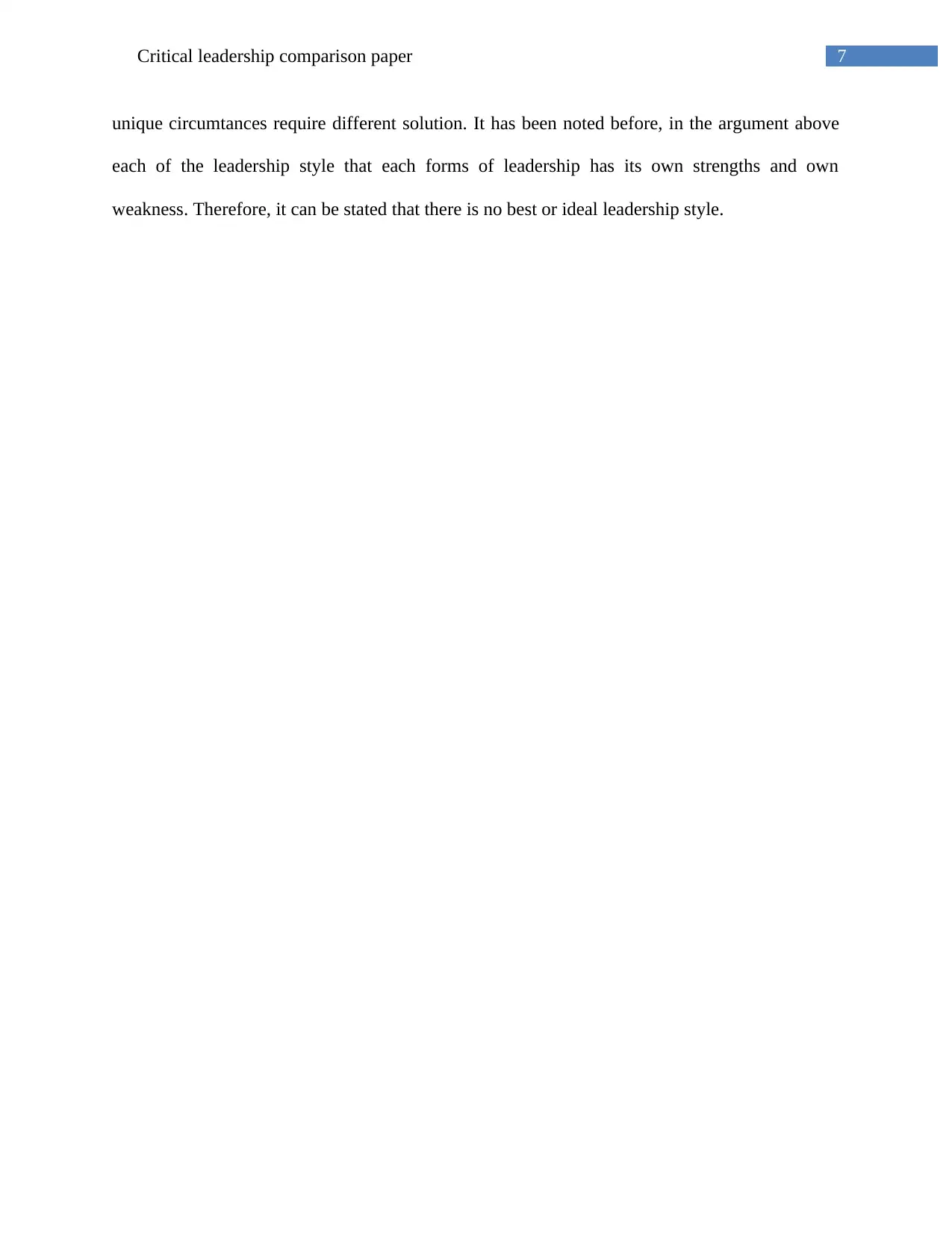
7Critical leadership comparison paper
unique circumtances require different solution. It has been noted before, in the argument above
each of the leadership style that each forms of leadership has its own strengths and own
weakness. Therefore, it can be stated that there is no best or ideal leadership style.
unique circumtances require different solution. It has been noted before, in the argument above
each of the leadership style that each forms of leadership has its own strengths and own
weakness. Therefore, it can be stated that there is no best or ideal leadership style.

8Critical leadership comparison paper
References:
Breevaart, K., Bakker, A., Hetland, J., Demerouti, E., Olsen, O. K., & Espevik, R. (2014). Daily
transactional and transformational leadership and daily employee engagement. Journal of
occupational and organizational psychology, 87(1), 138-157.
Brown, C. (2016). The servant leadership of Abraham Lincoln. Servant Leadership: Theory &
Practice, 2(1), 6.
Fosdick, R. B. (2017). The story of the Rockefeller Foundation. Routledge.
Hoch, J. E., Bommer, W. H., Dulebohn, J. H., & Wu, D. (2018). Do ethical, authentic, and
servant leadership explain variance above and beyond transformational leadership? A
meta-analysis. Journal of Management, 44(2), 501-529.
Leroy, H., Anseel, F., Gardner, W. L., & Sels, L. (2015). Authentic leadership, authentic
followership, basic need satisfaction, and work role performance: A cross-level study.
Journal of Management, 41(6), 1677-1697.
Liden, R. C., Wayne, S. J., Liao, C., & Meuser, J. D. (2014). Servant leadership and serving
culture: Influence on individual and unit performance. Academy of Management Journal,
57(5), 1434-1452.
McCleskey, J. A. (2014). Situational, transformational, and transactional leadership and
leadership development. Journal of Business Studies Quarterly, 5(4), 117.
References:
Breevaart, K., Bakker, A., Hetland, J., Demerouti, E., Olsen, O. K., & Espevik, R. (2014). Daily
transactional and transformational leadership and daily employee engagement. Journal of
occupational and organizational psychology, 87(1), 138-157.
Brown, C. (2016). The servant leadership of Abraham Lincoln. Servant Leadership: Theory &
Practice, 2(1), 6.
Fosdick, R. B. (2017). The story of the Rockefeller Foundation. Routledge.
Hoch, J. E., Bommer, W. H., Dulebohn, J. H., & Wu, D. (2018). Do ethical, authentic, and
servant leadership explain variance above and beyond transformational leadership? A
meta-analysis. Journal of Management, 44(2), 501-529.
Leroy, H., Anseel, F., Gardner, W. L., & Sels, L. (2015). Authentic leadership, authentic
followership, basic need satisfaction, and work role performance: A cross-level study.
Journal of Management, 41(6), 1677-1697.
Liden, R. C., Wayne, S. J., Liao, C., & Meuser, J. D. (2014). Servant leadership and serving
culture: Influence on individual and unit performance. Academy of Management Journal,
57(5), 1434-1452.
McCleskey, J. A. (2014). Situational, transformational, and transactional leadership and
leadership development. Journal of Business Studies Quarterly, 5(4), 117.
⊘ This is a preview!⊘
Do you want full access?
Subscribe today to unlock all pages.

Trusted by 1+ million students worldwide
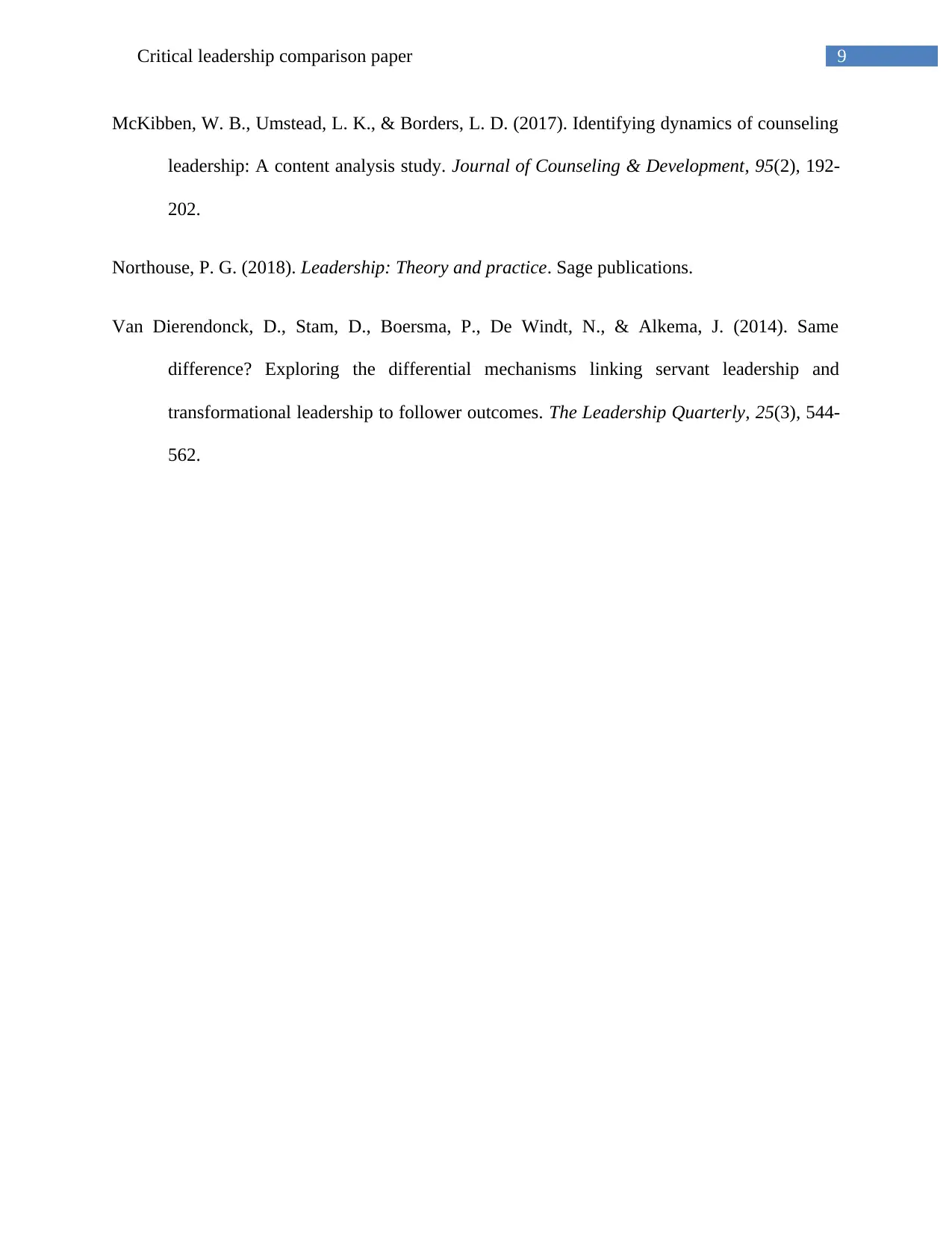
9Critical leadership comparison paper
McKibben, W. B., Umstead, L. K., & Borders, L. D. (2017). Identifying dynamics of counseling
leadership: A content analysis study. Journal of Counseling & Development, 95(2), 192-
202.
Northouse, P. G. (2018). Leadership: Theory and practice. Sage publications.
Van Dierendonck, D., Stam, D., Boersma, P., De Windt, N., & Alkema, J. (2014). Same
difference? Exploring the differential mechanisms linking servant leadership and
transformational leadership to follower outcomes. The Leadership Quarterly, 25(3), 544-
562.
McKibben, W. B., Umstead, L. K., & Borders, L. D. (2017). Identifying dynamics of counseling
leadership: A content analysis study. Journal of Counseling & Development, 95(2), 192-
202.
Northouse, P. G. (2018). Leadership: Theory and practice. Sage publications.
Van Dierendonck, D., Stam, D., Boersma, P., De Windt, N., & Alkema, J. (2014). Same
difference? Exploring the differential mechanisms linking servant leadership and
transformational leadership to follower outcomes. The Leadership Quarterly, 25(3), 544-
562.
1 out of 10
Related Documents
Your All-in-One AI-Powered Toolkit for Academic Success.
+13062052269
info@desklib.com
Available 24*7 on WhatsApp / Email
![[object Object]](/_next/static/media/star-bottom.7253800d.svg)
Unlock your academic potential
Copyright © 2020–2025 A2Z Services. All Rights Reserved. Developed and managed by ZUCOL.





